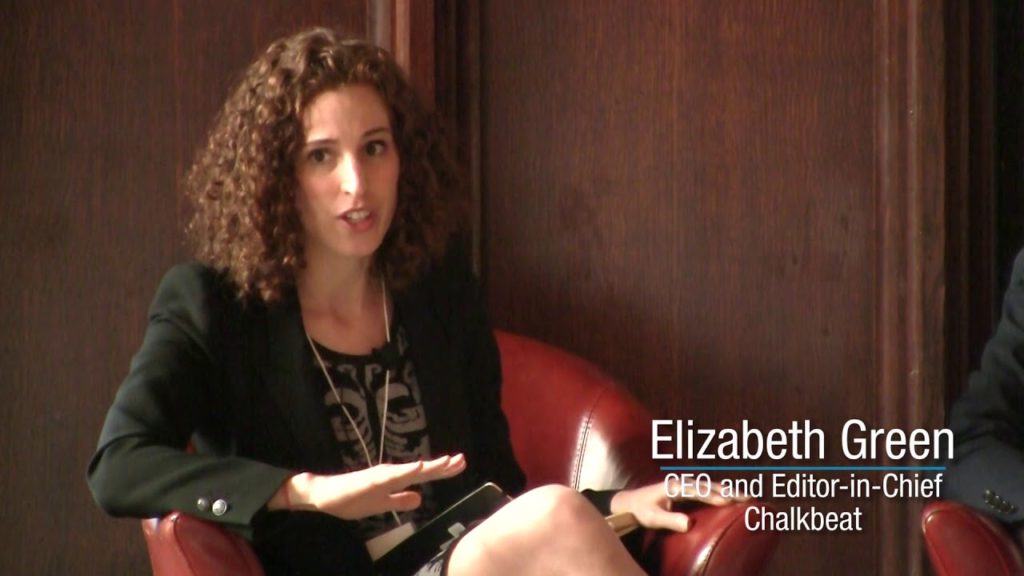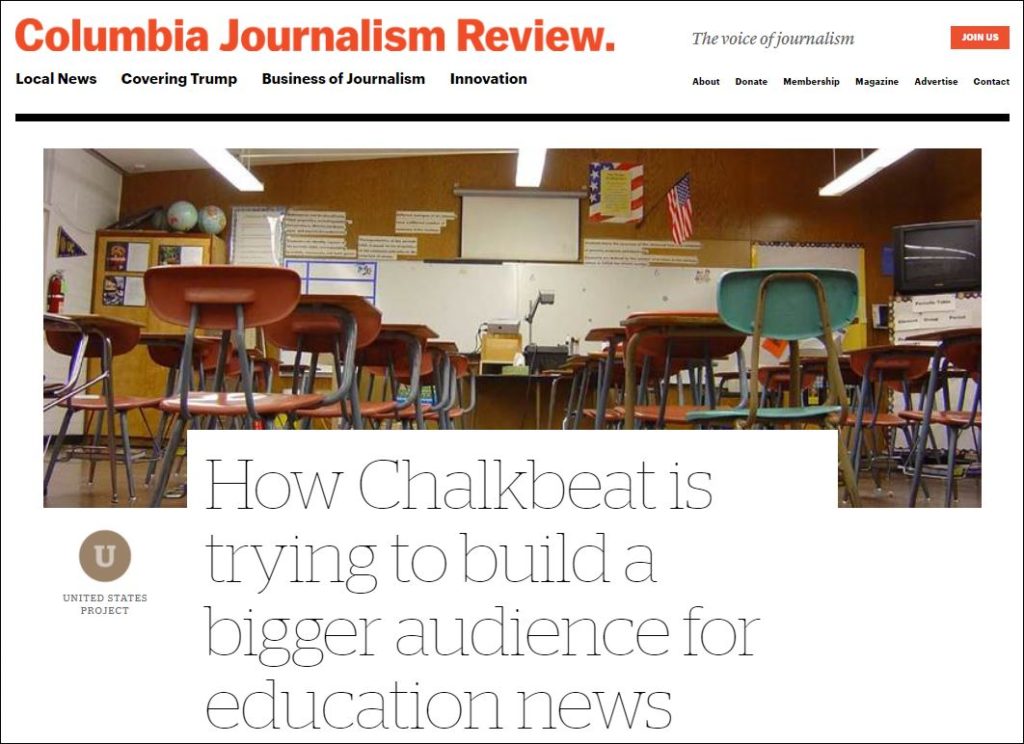Now five years old and 30+ journalists strong, the network of education news sites has made impressive progress but also faces some ongoing challenges
By Alexander Russo
On Monday, the nonprofit education news network Chalkbeat announced that its newsrooms now exceed 30 reporters and editors. That makes Chalkbeat “one of the largest nonprofit news organizations in the country,” according to the announcement penned by co-founder Elizabeth Green.
No doubt, what Chalkbeat co-founders Elizabeth Green and Philissa Cramer and their colleagues have created is a serious accomplishment. The vision, the fundraising, and the progress they’ve made are all admirable. At a fundamental level, Chalkbeat is accomplishing what it set out to do: provide ongoing, high-quality education news in places that don’t have enough of it.
“Stressed, constricted newsrooms have increasingly limited resources,” explained the McCormick Foundation’s Cornelia Grumman, whose organization is supporting the expansion in Chicago. As a result, “too many compelling education stories in the Chicago area are simply not getting told.”
But this latest expansion also raises a series of questions, both new and familiar. Has Chalkbeat improved as it has expanded? How much progress has it made in key areas such as earned (non-foundation) revenue and racial diversity in its newsrooms? What, if anything, distinguishes Chalkbeat’s coverage from others’ work? And – perhaps most important of all – what happens next?
As it turns out, the real story here may not be that Chalkbeat is expanding again but rather that the organization is making a big new push to reach a broader audience by improving the quality of its writing.

Co-founder Elizabeth Green, who is the most public face of the five-year-old education news network
On the surface, Chalkbeat’s success appears straightforward.
Education is a topic that affects more than 50 million school-age children and millions of classroom teachers. It holds a prominent place in the national conversation. And Chalkbeat — founded in 2013 as a network of four local teams — emerged in the right place at the right time. Nonprofit news outlets have proliferated in the past decade and have seen a spike in readership and contributions since the election of Donald Trump.
The network now includes seven regional bureaus: Colorado, Tennessee, Newark, Chicago, New York City, Indianapolis, and Detroit. There’s also a national desk. Outlets including the Indianapolis Star, the Memphis Commercial Appeal, the Denver Post, the Detroit Free Press, La Prensa Latina, and The Atlantic regularly publish its work. It’s been written up in the Columbia Journalism Review, USA Today, the New York Times, and Harvard’s Nieman Lab. Along the way, it’s won several awards.
In recent years, the network has also been able to attract and afford more experienced journalists. The latest hires include veterans from mainstream journalism such as Sara Mosle (formerly at New York Times Magazine and the New Yorker), Cassie Walker Burke (formerly at Chicago magazine and Crain’s), and Sharon Noguchi (longtime education reporter at the San Jose Mercury News). Chalkbeat is no longer a reporter’s first job.
Even in a place as full of journalists as New York City, Chalkbeat covers announcements, board meetings, and program launches that no other outlet does anymore. “These are the kinds of things that you used to get from Newsday, the Daily News, and even the New York Times,” says Clara Hemphill, who founded another New York City-based site, InsideSchools.org.
Hemphill says she reads Chalkbeat’s morning newsletter first thing every day.
And Chalkbeat’s arrival apparently hasn’t encouraged other outlets to give up on providing their own coverage, even though Chalkbeat encourages others to publish its work for free. “We wondered if that might happen, but if anything, it’s been the opposite,” Green says, citing as an example new education reporters hired by the Indianapolis Star and WFYI Public Media after Chalkbeat launched in Indiana in 2013.
But making single-focus, nonprofit news sites work is no easy endeavor, especially one without a sexy topic (like politics), big-name talent (like the former New York Times head Bill Kelly at The Marshall Project), or a prestigious fiscal sponsor (like The Hechinger Report, whose organizational base is Columbia University). And there have been a few seeming hiccups along the way.
Early on, reporters tended to be inexperienced. Turnover seemed high. A handful of senior staff entered and exited the organization.
Figuring out how to replicate a model in such different places has been an ongoing challenge (according to Green).
The national news desk is not as consistently strong it needs to be (according to me).
Previous coverage: Can Chalkbeat reach “casual” readers?

The Columbia Journalism Review featured the network in 2016
There a handful of ongoing challenges.
Securing and growing revenue is a big challenge for nonprofit news outlets, especially after the initial years pass by, as is hiring and retaining journalists who share the diversity of the communities they cover.
On the revenue front, the network’s current list of funders includes familiar names such as Walton, Gates, Carnegie Corporation, Lilly, Ford, McMormick, Knight, and Joyce. Its leaders have been smart about exploring paid revenue streams like live events and advertising, according to Hemphill.
Sponsorship revenue has been steady, according to Green, and recent experiments like its Great American Teach-Off have been successful at attracting national sponsors. At under 10 percent of its $5 million budget, however, sponsorship revenue is not nearly at the level Green would like it to be. That means Chalkbeat continues to rely on its many foundation supporters.
On the newsroom diversity front, Chalkbeat reported that 30 percent of its editorial team identified as journalists of color in last year’s newsroom roundup. By comparison, NPR’s education team reported a figure of 20 percent (the lowest among those who shared information). KPCC LA public radio reported a figure of 60 percent (the highest among those who shared information).
Some of the new Chalkbeat hires, announced Monday, are journalists of color. But the majority appear to be white. Both of the journalists newly hired to provide coverage of the Newark schools are white.
Chalkbeat’s Green says that the organization has set ambitious goals for diversity on its staff and is on track to meet them. It says that 33 percent of the current editorial team are people of color.
See previous coverage: Diversity in education journalism 2017

Chalkbeat’s latest hires (via Chalkbeat)
The biggest challenge may be making Chalkbeat’s journalism stand out.
Organizationally, Chalkbeat is distinguished for its decentralized bureau model, says Emily Roseman, research coordinator at Harvard’s Single Subject News Project. “This allows for really deep local education news in each of these bureaus and also gives us an interesting perspective when looking at how the analytics for each bureau compares.”
Another key difference: Most single-subject nonprofit news outlets – think the Marshall Project or The Hechinger Report – are national rather than local in their focus. And most local nonprofit news outlets – think Texas Tribune – aren’t focused on a single subject.
In terms of its journalism, however, the network is not known for particularly compelling storytelling. Their work is perhaps more sharply focused, more inventive, more readable than some other trade publications, but they haven’t done enough to make readers look up and pay attention, either. In an era of amazing nonfiction writing, it doesn’t stand out.
So is it enough to be what conservative Washington DC think tanker Mike Petrilli once described as “a geographically based Education Week”?
The answer from Chalkbeat seems to be “no.”
Last year, Green and Cramer wrote about hiring a new executive editor, Bene Cipolla, “to help us get better.” Specifically, the duo said that they wanted Chalkbeat to “cover a wider territory, take on more ambitious projects, and share more stories that haven’t yet been told.”
And Chalkbeat has recently hired several story editors, in part to help address the need to tell stories in more compelling ways and engage non-education readers.
The story editor position means that there’s an extra pair of eyes on local pieces. “It just makes everyone’s writing better when you have another pair of eyes on a story,” says Green.

A new Chalkbeat piece looking back at the impact of Martin Luther King, Jr’s assassination on educators and schools.
Chalkbeat certainly wasn’t the first local education news site. And it isn’t the only nonprofit education news team that has expanded in recent years. But the network is fast approaching the size of Education Week, which has close to 40 full-time reporters and editors, according to managing editor Kathleen Manzo.
With any luck, the Chalkbeat expansion will continue – to the Bay Area, and then perhaps to Washington DC (where education coverage has been sorely lacking).
In the meantime, Chalkbeat alumni like Maura Walz (now at KPCC Los Angeles), Anna Phillips (at the LA Times), and Daarel Burnette II (now at Education Week) – are doing great work in other places.
And there are still several open positions listed Chalkbeat’s jobs page.
ABOUT THE AUTHOR

Alexander Russo
Alexander Russo is founder and editor of The Grade, an award-winning effort to help improve media coverage of education issues. He’s also a Spencer Education Journalism Fellowship winner and a book author. You can reach him at @alexanderrusso.
Visit their website at: https://the-grade.org/












